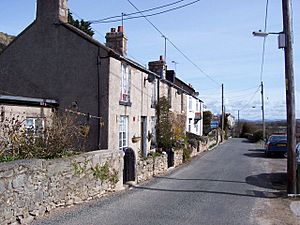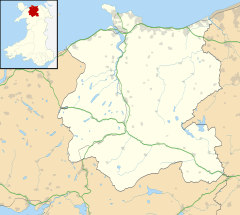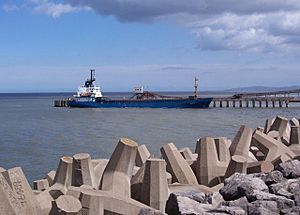Llysfaen facts for kids
Quick facts for kids Llysfaen |
|
|---|---|
 Llysfaen |
|
| Population | 2,743 (2011) |
| OS grid reference | SH887771 |
| Community |
|
| Principal area |
|
| Ceremonial county | |
| Country | Wales |
| Sovereign state | United Kingdom |
| Post town | COLWYN BAY |
| Postcode district | LL29 |
| Dialling code | 01492 |
| Police | North Wales |
| Fire | North Wales |
| Ambulance | Welsh |
| EU Parliament | Wales |
| UK Parliament |
|
| Welsh Assembly |
|
Llysfaen is a small village in Conwy County Borough, Wales. It sits on a hill called Mynydd Marian, looking out over the northern coast of Wales. Llysfaen is also a "community" and a "ward" for local government purposes. This means it has its own local council that helps run things. The area includes the Peulwys estate, which is part of Old Colwyn.
Contents
Discover Llysfaen: Location and Nature
Llysfaen is located about one kilometre (0.6 miles) inland. It is found between the coastal towns of Abergele and Colwyn Bay. Nearby villages include Old Colwyn, Llanddulas, Dolwen, and Betws-yn-Rhos.
Natural Wonders Around Llysfaen
To the west of Llysfaen is Mynydd Marian. This is a mountain famous for its limestone grassland. It is also home to a special, rare type of silver-studded blue butterfly. To the east, you can find Craig y Forwyn. From Llysfaen, you can see the Irish Sea. You can also spot Kinmel Bay, Rhyl, and the Clwydian Range mountains.
Llysfaen's Size and Name
The Llysfaen area, including the village, covers about 5.11 square kilometres (1,260 acres). The number of people living here has stayed about the same. In 2001, there were 2,652 residents. The name Llysfaen comes from the Welsh language. It means "stone court," which suggests a court or meeting place built from stone.
For a long time, many people in Llysfaen worked at the nearby Limestone Quarry. This quarry was called Llysfaen and Llanddulas. From here, lime was sent by ship to places like Liverpool or Fleetwood. This happened using Raynes Jetty in Llanddulas Bay.
Village Life: Facilities and Activities
Llysfaen has several useful facilities for its residents. These include a primary school, Ysgol Cynfran. This school teaches children from nursery age up to 11 years old.
Local Amenities
The village also has a small convenience store. There is the old mediaeval St. Cynfran's parish church, which you can read more about below. You'll find a village hall, a playgroup for younger children, and three parks. There's also a small hairdressers and barbers, two telephone boxes, and two post boxes. A mobile library from Conwy Library Service visits the village every three weeks.
Sports and Recreation
Llysfaen is home to several youth football teams. These teams are for ages 7 to 18, and there's a men's team too. Most of their games are played on the village's "Banana Pitch." It's called that because it dips quite a bit in the middle! The village also has a bowling green for lawn bowls. There's a MUGA where people can play netball, tennis, and hockey.
Llysfaen Through Time: A Glimpse into History
The patron saint of Llysfaen is Saint Cynfran. People believe he founded the church in the village in the year 777. Above the church entrance, there's a carving of the saint in rock. The local primary school, Ysgol Cynfran, is also named after him.
The Ancient St. Cynfran's Church
St. Cynfran's church has been rebuilt many times over the years. The current building has two naves (main parts of the church) and is thought to be from 1377. It likely uses stones from the very first church. In 1870, the church had a big internal restoration. Only a few parts from the Middle Ages remained, but the old stone walls are still there. The churchyard has memorials dating back to the 1600s. It is surrounded by a stone wall with yew trees. About 100 metres north of the church, there is a holy well called Ffynnon Gynfran.
Changes in Llysfaen's Boundaries
The ancient parish of Llysfaen was once a separate piece of land (an exclave) belonging to Caernarfonshire. It included areas like Isallt, Isyffordd, Pant, Penmaen, and Rhwngyddwyffordd. In 1831, the parish had 585 people, growing to 1,489 by 1901.
The parish was a bit larger in the 1840s, covering 1,772 acres. In 1872, some land was given to Colwyn, but the area of Twynnan was gained from Llanelian-yn-Rhos. By 1910, the parish had grown to 1,879 acres.
Quarrying and Industry
In 1873, a local company called Raynes & Co. Ltd was started by James Trevelyan Raynes II. They worked in lime quarrying. They made sodium carbonate and limestone dust, which were used to make glass.
Llysfaen in the 20th Century
- 1923: The parish of Llysfaen officially moved from Caernarfonshire to Denbighshire.
- 1927: The United Alkali Company Ltd took over Raynes & Co. Later that same year, Imperial Chemical Industries (ICI) bought the United Alkali Company.
- 1931: Llysfaen railway station closed down. However, the signal box stayed until 1983 because it was used for the ICI lime works.
- 1972: The church had another restoration.
- 1974: Most of Denbighshire, including Llysfaen, became part of the larger area called Clwyd. Llysfaen also became part of the borough of Colwyn.
- 1996: As Wales was reorganised into unitary authorities, Llysfaen became part of the county borough of Conwy.
How Llysfaen is Governed
Llysfaen has its own electoral ward. This ward has the same boundaries as the Llysfaen community. One county councillor is chosen to represent Llysfaen on the Conwy County Borough Council. In the May 2017 election, the Conservative Party won this seat. Before that, the Labour party had held it since 1995.
Llysfaen also has its own community councillors. These councillors are elected to represent the people on the Llysfaen Community Council. They represent the community wards of Peulwys and Upper Llysfaen.




